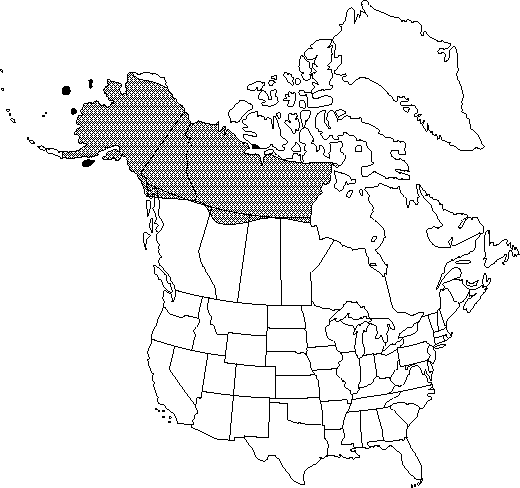Betula nana subsp. exilis
Fl. Alaska Yukon 4: 579. 1944.
Shrubs, spreading, depressed, to 1 m. Bark reddish brown. Twigs glabrous to very sparsely pubescent, conspicuously resinous, with relatively few small, resinous glands. Leaf blade broadly orbiculate to reniform, 0.5–1.2 × 0.5–1.6 cm, base rounded to nearly cordate or cuneate; surfaces abaxially glabrous, occasionally with only a few small, resinous glands. Infructescences 0.5–1.2 × 0.5–0.7 cm; scales glabrous, lobes diverging distal to middle, held nearly parallel, center lobe ascending, slightly longer than lateral lobes. 2n = 28.
Phenology: Flowering late spring.
Habitat: Wet tundra and margins of bogs, terraces and open slopes
Elevation: 0–2400 m
Distribution

Alta., B.C., Man., N.W.T., Nunavut, Sask., Yukon, Alaska, n Asia.
Discussion
The range of Betula nana subsp. exilis stretches through Siberia and across northwestern North America. It is sometimes confused with Betula glandulosa Michaux; it can be distinguished from that species by its usually much smaller, rounded to truncate-tipped leaves that have teeth all the way to the base (the base being mostly toothless in B. glandulosa). Betula nana subsp. exilis has been combined into B. glandulosa by several authors (E. H. Moss and J. G. Packer 1983; A. E. Porsild and W. J. Cody 1980). The two taxa hybridize and form a sometimes bewildering assortment of intermediates in the extensive region where their ranges overlap; they constitute well-defined entities away from the area of contact. The current treatment follows the view of E. Hultén (1968) that two distinct species of dwarf arctic birches inhabit northern North America. Little is understood, however, about the evolutionary or phytogeographic history of this complex, and many problems remain to be unraveled before a truly satisfactory classification can be attained.
Western Eskimos used decoctions prepared from the leaves of Betula nana subsp. exilis to alleviate intestinal discomfort (D. E. Moerman 1986).
Selected References
None.